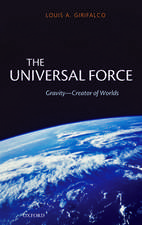Analysis of Material Removal Processes: Mechanical Engineering Series
Autor Warren R. DeVriesen Limba Engleză Hardback – 20 noi 1991
| Toate formatele și edițiile | Preț | Express |
|---|---|---|
| Paperback (1) | 387.20 lei 6-8 săpt. | |
| Springer – 2 oct 2011 | 387.20 lei 6-8 săpt. | |
| Hardback (1) | 394.29 lei 6-8 săpt. | |
| Springer – 20 noi 1991 | 394.29 lei 6-8 săpt. |
Din seria Mechanical Engineering Series
-
 Preț: 391.84 lei
Preț: 391.84 lei - 18%
 Preț: 1110.72 lei
Preț: 1110.72 lei - 15%
 Preț: 593.73 lei
Preț: 593.73 lei - 18%
 Preț: 944.99 lei
Preț: 944.99 lei - 15%
 Preț: 653.14 lei
Preț: 653.14 lei - 17%
 Preț: 363.13 lei
Preț: 363.13 lei - 18%
 Preț: 1239.05 lei
Preț: 1239.05 lei - 15%
 Preț: 640.06 lei
Preț: 640.06 lei - 18%
 Preț: 1129.65 lei
Preț: 1129.65 lei - 15%
 Preț: 522.24 lei
Preț: 522.24 lei - 15%
 Preț: 654.77 lei
Preț: 654.77 lei - 15%
 Preț: 643.34 lei
Preț: 643.34 lei - 15%
 Preț: 611.40 lei
Preț: 611.40 lei - 18%
 Preț: 765.96 lei
Preț: 765.96 lei - 20%
 Preț: 631.71 lei
Preț: 631.71 lei - 18%
 Preț: 1009.22 lei
Preț: 1009.22 lei -
 Preț: 418.34 lei
Preț: 418.34 lei - 15%
 Preț: 640.71 lei
Preț: 640.71 lei -
 Preț: 403.53 lei
Preț: 403.53 lei - 18%
 Preț: 813.97 lei
Preț: 813.97 lei - 18%
 Preț: 1386.48 lei
Preț: 1386.48 lei - 18%
 Preț: 951.47 lei
Preț: 951.47 lei - 18%
 Preț: 833.09 lei
Preț: 833.09 lei - 18%
 Preț: 936.60 lei
Preț: 936.60 lei - 15%
 Preț: 644.49 lei
Preț: 644.49 lei - 18%
 Preț: 941.05 lei
Preț: 941.05 lei - 18%
 Preț: 1386.17 lei
Preț: 1386.17 lei -
 Preț: 399.67 lei
Preț: 399.67 lei - 18%
 Preț: 1389.44 lei
Preț: 1389.44 lei - 18%
 Preț: 790.46 lei
Preț: 790.46 lei - 18%
 Preț: 1388.22 lei
Preț: 1388.22 lei - 18%
 Preț: 1024.53 lei
Preț: 1024.53 lei - 15%
 Preț: 590.16 lei
Preț: 590.16 lei - 18%
 Preț: 1234.00 lei
Preț: 1234.00 lei - 18%
 Preț: 1386.62 lei
Preț: 1386.62 lei - 15%
 Preț: 543.85 lei
Preț: 543.85 lei -
 Preț: 391.61 lei
Preț: 391.61 lei - 18%
 Preț: 944.19 lei
Preț: 944.19 lei - 18%
 Preț: 736.16 lei
Preț: 736.16 lei - 18%
 Preț: 943.88 lei
Preț: 943.88 lei - 15%
 Preț: 693.21 lei
Preț: 693.21 lei - 18%
 Preț: 781.77 lei
Preț: 781.77 lei - 15%
 Preț: 639.08 lei
Preț: 639.08 lei - 23%
 Preț: 737.29 lei
Preț: 737.29 lei - 15%
 Preț: 641.53 lei
Preț: 641.53 lei -
 Preț: 401.42 lei
Preț: 401.42 lei
Preț: 394.29 lei
Nou
Puncte Express: 591
Preț estimativ în valută:
75.46€ • 81.93$ • 63.38£
75.46€ • 81.93$ • 63.38£
Carte tipărită la comandă
Livrare economică 22 aprilie-06 mai
Preluare comenzi: 021 569.72.76
Specificații
ISBN-13: 9780387977287
ISBN-10: 0387977287
Pagini: 276
Ilustrații: XVIII, 254 p.
Dimensiuni: 156 x 234 x 20 mm
Greutate: 0.56 kg
Ediția:1992
Editura: Springer
Colecția Springer
Seria Mechanical Engineering Series
Locul publicării:New York, NY, United States
ISBN-10: 0387977287
Pagini: 276
Ilustrații: XVIII, 254 p.
Dimensiuni: 156 x 234 x 20 mm
Greutate: 0.56 kg
Ediția:1992
Editura: Springer
Colecția Springer
Seria Mechanical Engineering Series
Locul publicării:New York, NY, United States
Public țintă
ResearchCuprins
1. Introduction.- 1.1 The Design Problem In Material Removal — Process Planning.- 1.2 Analysis of Material Removal for Process Planning.- 1.3 References.- 2. Metrology, Quality Control and Data Analysis.- 2.1 Metrology.- 2.2 Tolerancing.- 2.3 Quality Control.- 2.4 Experimental Design Methods for Empirical Data.- 2.5 References.- 2.6 Problems.- 3. Mechanics and Thermal Models for Machining.- 3.1 Classification of Chip Formation.- 3.2 Mechanics Models for Machining.- 3.3 Steady State Temperatures.- 3.4 References.- 3.5 Problems.- 4. Edge Materials, Wear and Fluids for Cutting and Grinding.- 4.1 Cutting Edge Materials.- 4.2 Cutting and Grinding Fluids.- 4.3 Wear of Cutting Edges.- 4.4 References.- 4.5 Problems.- 5. Practical Machining Processes.- 5.1 Common Factors and Analysis Methods.- 5.2 Turning and Facing.- 5.3 Face and End Milling.- 5.4 Drilling.- 5.5 References.- 5.6 Problems.- 6. Grinding Processes.- 6.1 Comparing Grinding With Cutting Processes.- 6.2 Terms and Specifications for the Grinding System.- 6.3 Kinematics of Grinding.- 6.4 Calculations for Planning a Grinding Cycle.- 6.5 References.- 6.6 Problems.- 7. Machining Economics and Optimization.- 7.1 Terms and Notation for Turning Optimization.- 7.2 Maximum Production Rate or Minimum Production Time.- 7.3 Minimum Unit Cost.- 7.4 Maximum Profit Rate.- 7.5 References.- 7.6 Problems.- 8. Modeling Machining Vibration for Stability Analysis.- 8.1 Classification of the Types of Vibration in Machining.- 8.2 Stability Analysis in Turning.- 8.3 Stability Analysis of Cylindrical Plunge Grinding.- 8.4 Some Practical Ways to Diagnose and Minimize Chatter.- 8.5 References.- 8.6 Problems.- Appendix Code for Simulation Examples.- 1 C Code for Example 5.3 Simulation of Face Milling.- 2 C Code for Example 8.1 Single Degree ofFreedom Stability Analysis for Turning.












